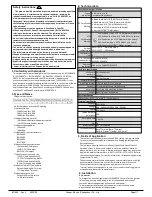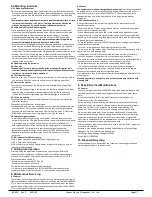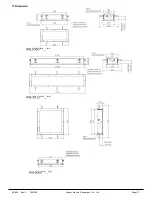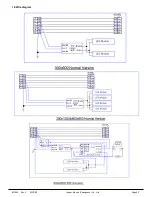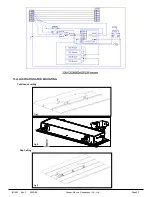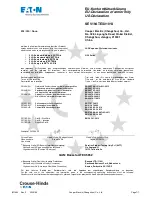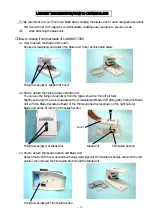
IM1465 Rev.2 2020/09 Cooper Electric (Changzhou) Co., Ltd. Page2/7
6.2 Mounting luminaire
6.2.1 Mounting the bracket
Only use the accompanying mounting bracket! Securely fasten the mounting
bracket to a suitable base with sufficient load-bearing capacity. The mounting
should be secured with M6 bolts and relative lock washers, nuts should be
used.
The minimum distance between the luminaire and illuminated surface, directly
in front of the luminaire, is 0.5 meter. The lamp must not be illuminated
when at a distance of less than 0.5m from inflammable material
6.3 Cable entries/Plugs and Breathing valve
The “Increased safety (Exe)" properties must be preserved when select and
mount cable entry/plug and breathing valve. Unused holes must be closed
with certified plug to establish the Exe protection category. The cable
glands/plugs and breathing valve should be Ex tb certified if the whole
product is Ex tb certified also.
Cable entries sealing washer(if required by
manual of cable gland/plug) must be used to obtain IP66.
The authoritative mounting guidelines for the cable glands and breathing valve
used must be observed. Mounting the selected cable entries acc. type and
dimensions of the main connection cable following their manufacturer
instructions. The cable temperatures are given as the rise over the max. rated
ambient (Tamb). This allows the user to adjust the cable specification for
actual maximum site ambient. Only heat resistant cable according to the data
on the type label may be used! The max. conductor size is 6mm². The standard
looping cable size is 4mm².
6.4 Opening/closing the luminaire
6.4.1 General
The opening of luminaire always shall be without voltage! All gasket seals
must be clean and undamaged before closing the luminaire. Make sure the
luminaires is well closed before operation!
6.4.2 Exe chamber cover
Open the cover with PC cover. And carry out the steps in reverse order to close
the luminaire. Check all screws to ensure a secure fit during operation .
6.5 Electrical connection
The electrical connection of the lamp must only be established by qualified
electricians.
Make sure the supply voltage is the same as the luminaire voltage! Use proper
supply wiring as specified on the nameplate of the luminaire and in this
instructions! Excessive tightening may affect or damage the connection.
6.5.1 Wire connection
The conductors shall be connected with special care in order to maintain the
explosion category.
The conductor itself shall not be damaged.
The connectible min. and max. conductor cross-sections shall be observed (see
technical data). All terminals, used and unused, shall be fully tightened to
prevent incorrect selection between 1.2Nm for Exe T 6P and 1.5~1.8Nm for
MBK. Main connection: See wiring diagram. See Fig.4 for details.
6.6 Emergency light attention:
In mains operation the light fitting is charged by means of constant current
output from inverter. Charging takes place via the un-switched external phase
L to prevent an interruption, even when the luminaire is switched off.
With regular operation of the light fitting, the charging time is requested to
more than 12h. It is suitable for a continuous charge of the battery.
Standard emergency discharge time is 90min for EM2, 180min for EM3.
Regularly inspection on battery states. Check if the battery cell is leak is
necessary.
6.7 LED indicator for HRL emergency:
• LED is green light when normal work and charging battery;
• LED is flash when discharging;
• LED will not work, when no supply power, or inverter & battery is bad, or
battery is full discharged;
7. Putting into operation
Prior to putting the apparatus into operation, the tests specified in the
relevant national regulations shall be carried out. Insulation measurements
may only be carried out between PE and the external conductor L1 (L2, L3)
as well as between PE and N.
- Measurement voltage: Max. 1.5 KV AC
- Measurement current: Max.5 mA
The luminaire may only be operated when closed.
It is generally recommended (see IEC/EN 60079-14) that you ensure the
type of protection of the construction is not impaired during installation.
8. Maintenance/Servicing
8.1 General
The relevant national regulations which apply to the maintenance/servicing of
electrical apparatus in explosive atmospheres, shall be observed (EN/IEC 60079-
17). The interval between maintenance depends upon the ambient conditions
and the hours of operation. The recommendations given within EN/IEC 60079-
17 for recurring checks must be observed.
8.2 Checks
The equipment must be de-energised before opening
Visual inspection should
be carried out at a minimum of 12 monthly intervals and more frequently if
conditions are severe, refer to EN/IEC 60079-17. The time between lamp
changes could be very infrequent and this is too long a period without
inspection.
8.3 Routine Examination
During maintenance, the parts affecting the level of protection must be
checked in particular:
- Ensure the lamp is lit when energised and examine the enclosure and glass
for any signs of cracks and damage.
- When de-energised and left to cool, there should be no significant sign of
internal moisture. If there are signs of water ingress, the luminaire should be
opened up, dried out, and any likely ingress points eliminated by re-gasketing,
re-greasing or other replacement.
- Check the gasket of pc cover and LED housing for any damage or permanent
set and replace as required.
- Terminal, screw glands and blanking plugs for secure fitting.
- To maintain the light output, clean the protective pc cover periodically with a
damp cloth or a mild cleaning fluid.
- If this product is used in the combustible dust area, outside of enclosure
must be cleaned on a regular basis to prevent accumulation of dust.
- The cable connections should be checked for tightness. The gasket should be
checked for cracks or lack of elasticity, and if necessary, replaced.
- Check that mountings are secure and the adjusting bolts are tight.
- If it has been suspected that the luminaire has mechanical damage, a
stringent workshop overhaul will be required. Where spares are needed,
these must be replaced with factory specified parts.
No modifications should be made without the knowledge and approval of the
manufacturer.
Cleaning the joint of housing assy. and pc cover use a damp cloth or a mild
cleaning fluid.
9. Repair/Overhaul/Modifications
9.1 General
The national regulations EN/IEC60079-19 have to be observed! Repairs and
overhaul may only be carried out with genuine Eaton Crouse-Hinds spare
parts.
In the case of battery failure, the battery pack must be replaced as a
complete unit from the manufacture.
Before replacing or disassembling individual parts, observe the following:
Disconnect the power supply to the equipment before maintenance/repair.
Make sure that there is no explosive atmosphere when opening the
equipment. See section 8.4 for notes on opening and closing the lamp.
Only use original spare parts. If the luminaire was previously in operation
then wait to cool enough before opening. Repairs that affect the explosion
protection, may only be carried out by Eaton Crouse-Hinds or a qualified
electrician in compliance with the applicable national rules. Modifications to
the device or changes to its design are not permitted.
After carrying out repair or overhaul work, ensure that the “Exde" properties
have not been affected.
Assistance may also be obtained through Cooper Electronic Technologies
(Shanghai) Co., Ltd. Sales Service department,
955 ShengLi Road, Pudong Shanghai 201201
Phone (86) 21-28993943
10. Disposal/Recycling
When the apparatus is disposed of, the respective national regulations on
waste disposal will have to be observed.


